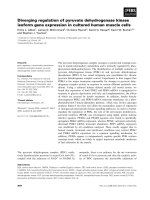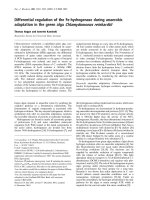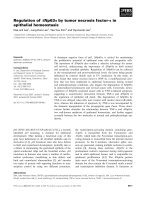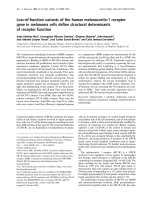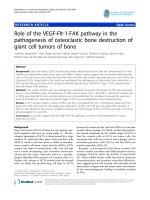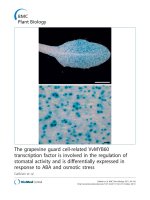Regulation of na+ h+ exchanger 1 (NHE1) stability in PTEN mouse embryonic fibroblasts
Bạn đang xem bản rút gọn của tài liệu. Xem và tải ngay bản đầy đủ của tài liệu tại đây (1.94 MB, 214 trang )
REGULATION OF Na
+
/H
+
EXCHANGER 1 (NHE1) STABILITY IN
PTEN
-/-
MOUSE EMBRYONIC FIBROBLASTS
JOANNE JAMES
B.Sc. Hons
(University of Queensland)
A THESIS SUBMITTED
FOR THE DEGREE OF DOCTOR OF PHILOSOPHY
NUS GRADUATE SCHOOL FOR
INTEGRATIVE SCIENCES AND ENGINEERING
NATIONAL UNIVERSITY OF SINGAPORE
2013
i
DECLARATION
I hereby declare that the thesis is my original work
and it has been written by me in its entirety. I have
duly acknowledged all the sources of information
which have been used in the thesis.
This thesis has also not been submitted for any
degree in any university previously.
JOANNE JAMES
23 September 2013
ii
ACKNOWLEDGEMENTS
Firstly, I would like to express my sincere appreciation and gratitude towards
my supervisor, Associate Professor Marie-Veronique Clement for her constant
guidance, patience and support she has given me throughout my graduate
study in NUS.
Also, I would like to thank my TAC members, Prof Sit Kim Ping and Dr Chen
Ee Sin for their invaluable input towards my project. I am extremely grateful to
Dr Jaspal, for her guidance and support in my project. In addition, I would like
to express my sincere appreciation to Dr Jeya for the constant encouragement
and San Min, Giree and the rest of the lab members who have been a great
source of support during tough times.
Importantly, I would like to thank my fiancé Nathaniel who has stood by me in
times of distress and been a pillar of strength for me. Thank you for your
patience, love and support always and for bringing out the best in me.
Last but never least, I want to express my heartfelt appreciation to my Dad,
Mum, brother and sister-in law for their words of encouragement in tough
times. I am extremely grateful to my wonderful parents for their unconditional
love, support and for believing in me. Thank you for teaching me to be resilient
towards achieving my dreams. Finally, I dedicate this dissertation to my
parents.
iii
TABLE OF CONTENTS
DECLARATION i
ACKNOWLEDGEMENTS ii
TABLE OF CONTENTS iii
SUMMARY vii
LIST OF TABLES ix
LIST OF FIGURES ix
LIST OF ABBREVIATIONS xii
CHAPTER 1: INTRODUCTION 1
1.1 Na
+
/H
+
exchanger-1 (NHE1) 1
1.1.1 NHE1 isoforms and NHE1 structure 1
1.1.2 Regulation of NHE1 3
1.1.3. Physiological function of NHE1 7
1.1.4 Role of NHE1 in cancer progression 11
1.1.5 Link between NHE1 and PI3K/Akt pathway in cell survival 14
1.2 PI3-Kinase (PI3K)/Akt Pathway 16
1.2.1 Structure of Akt and its isoforms 16
1.2.2 Activation of Akt 18
1.2.3 Negative regulation of PI3K/Akt pathway 21
1.2.4 Physiological role of Akt pathway 23
1.2.5 Akt in tumourigenesis 26
AIM OF STUDY 32
CHAPTER 2: MATERIALS AND METHODS 33
2.1 Materials 33
2.1.1 Chemicals and reagents 33
2.1.2 Antibodies 34
iv
2.1.3 Cell lines and cell culture 35
2.2 Methods 35
2.2.1 RNA Interference (RNAi) Assay 35
2.2.2 RNA Extraction and Real-Time PCR 36
2.2.3 Sodium Dodecyl sulphate polyacrylamide gel electrophoresis (SDS-
PAGE) and Western blot analysis 38
2.2.4 Membrane/Cytosol fractionation 39
2.2.5 Immunoprecipitation assay 40
2.2.6 Statistical Analysis 41
CHAPTER 3: RESULTS 42
3.1 NHE1 is a Hsp90 client protein 42
3.1.1 Increase in NHE1 protein expression in MEF
PTEN-/-
cells compared to
MEF
PTEN+/+
cells does not correlate with an increase in NHE1 mRNA
production 42
3.1.2 NHE1 protein stability is prolonged in MEF
PTEN-/-
cells as compared
to MEF
PTEN+/+
cells 45
3.1.3 Proteasome inhibition increases NHE1 stability in MEF
PTEN+/+
cells
but have no effect in MEF
PTEN-/-
cells 49
3.1.4 Hsp90 may be involved in stabilizing NHE1 protein expression in
MEF
PTEN-/-
cells 52
3.1.5 Increased binding of Hsp90 and NHE1 protein in MEF
PTEN-/-
cells . 55
3.1.6 Effect of inhibition of Hsp90 activity on NHE1 expression in
MEF
PTEN-/-
cells 56
3.1.7 Inhibition of Hsp90 destabilizes NHE1 Protein in MEF
PTEN-/-
cells 65
3.1.8 Hsp90 prevents ubiquitination of NHE1 protein in MEF
PTEN-/-
cells 67
3.2 Akt is responsible for bringing Hsp90 to the membrane and increasing
NHE1 stability in MEF
PTEN-/-
cells 70
3.2.1 Hyperphosphorylation of Akt correlates with an increased level of
NHE1 in MEF
PTEN-/-
cells 70
3.2.2 NHE1 binds to Akt in MEF
PTEN-/-
cells 87
v
3.2.3 Akt is a client protein of Hsp90 89
3.2.4 NHE1 forms a complex with Hsp90 and Akt in MEF
PTEN-/-
cells 102
3.2.5 Hsp90-Akt downregulation affects cell survival in MEF
PTEN-/-
cells 111
3.3 The NHE1-Hsp90-Akt complex is a model of breast cancer progression
113
3.3.1 Regulation of NHE1 protein expression in MCF10AT1Kcl.2 series of
breast cancer cell lines 113
3.3.2 Stabilisation of Akt induces formation of Hsp90/Akt/NHE1 complex
in MCF10AT1 124
3.3.3 Akt regulates NHE1 protein expression in MCF10CA1a 131
3.3.4 NHE1 interacts with Akt in MCF10CA1a and not MCF10CA1h 134
3.3.5 Akt-Hsp90 complex is detectable in MCF10CA1a but is absent in
MCF10CA1h breast cancer cells 136
3.3.6 Hsp90 stabilizes NHE1 protein expression through direct interaction
in MCF10Ca1a breast cancer cell lines 138
3.4 NHE1 regulates Akt phosphorylation at Ser 473 site in MEF
PTEN-/-
and
MCF10CA1a cells 144
3.4.1 Downregulation of NHE1 dephosphorylates Akt at Ser 473 in
MEF
PTEN-/-
and MCF10CA1a cells 144
CHAPTER 4: DISCUSSION 151
4.1 NHE1 is a potential client protein of Hsp90 in MEF
PTEN-/-
cells 151
4.1.1 Increased stability of NHE1 protein in MEF
PTEN-/-
cells in comparison
to MEF
PTEN+/+
cells 151
4.1.2 Hsp90 confers protection to NHE1 in MEF
PTEN-/-
cells 155
4.2 Akt mediates regulation of NHE1 in MEF
PTEN-/-
cells 159
4.2.1 Regulation of NHE1 by Akt occurs at a protein level and not
transcriptionally in MEF
PTEN-/-
cells 159
4.2.2 Regulation of NHE1 by Akt in MEF
PTEN-/-
cells is independent of
NHE1 activity 162
4.2.3 NHE1 acts as a scaffold for Akt 163
vi
4.2.4 Hsp90 protects hyperphosphorylated Akt from degradation in
MEF
PTEN-/-
cells 164
4.2.5 Hsp90 recruitment to the membrane is dependent on Akt in
MEF
PTEN-/-
cells 165
4.2.6 Hsp90-Akt complex stabilizes NHE1 at the plasma membrane in
MEF
PTEN-/-
cells 166
4.3 Physiological relevance of novel NHE1-Akt-Hsp90 complex in
MCF10AT1kcl.2 breast cancer series 169
4.3.1 Detection of novel Hsp90-Akt-NHE1 complex in malignant
MCF10CA1a breast epithelial cells 169
4.3.2 The stability of Akt may play a role in the transition between pre-
malignant MCF10AT1 to malignant MCF10CA1a breast epithelial cells 172
4.4. Regulation of Akt Ser 473 phosphorylation by NHE1 in both MEF
PTEN-/-
cells and MCF10CA1a breast epithelial cells 174
4.4.1 NHE1 scaffolding function promotes the regulation of Akt Ser 473
phosphorylation in both MEF
PTEN-/-
cells and MCF10CA1a breast epithelial
cells 174
CONCLUSION 177
REFERENCES 180
APPENDICES 197
PUBLICATION AND PRESENTATIONS 199
vii
SUMMARY
The Na
+
/H
+
Exchanger 1 (NHE1), a membrane antiporter, has been implicated
in tumour cell survival. However, the regulation of NHE1 expression level in
tumour cells is not completely understood. Interestingly, the upregulation of
NHE1 protein expression in PTEN-null Mouse embryonic fibroblasts
(MEF
PTEN-/-
) compared to PTEN-wildtype Mouse embryonic fibroblasts
(MEF
PTEN+/+
) does not correlate with an increase in NHE1 transcription.
Hence, we hypothesized that increased NHE1 expression may be due to
increased stability of the protein.
In the current study, we show that Heat shock protein 90 (Hsp90) confers
stability to NHE1 though enhanced interaction in MEF
PTEN-/-
cells as compared
to MEF
PTEN+/+
cells. The inhibition of Hsp90 activity using Geldanamycin and
silencing of Hsp90 gene induced a decrease in NHE1 protein level in
MEF
PTEN-/-
cells while no effect was observed in control cells. In addition,
NHE1 was found to interact with Akt in MEF
PTEN-/-
cells. Both inhibition of Akt
activation and silencing Akt gene expression decreased NHE1 protein
expression. Moreover, our data reveals that Akt is involved in trafficking
Hsp90 from the cytosol to the plasma membrane in MEF
PTEN-/-
cells. Similar
result was observed in MCF10CA1a, a breast carcinoma cancer cell line.
Additionally, we found that NHE1 may be involved in the regulation of Akt
Serine 473 phosphorylation. We show that this occurs through the complex
formation between NHE1, mTOR, Rictor in both MEF
PTEN-/-
and MCF10CA1a
viii
cells. Taken together, this study establishes a possible tripartite complex
between NHE1, Akt and Hsp90 that may be critical for stabilizing NHE1
expression level and its role in survival of tumour cells. We propose that our
findings might be critical for the development and maintenance of tumour
cells. Indeed, results from this study could establish a new strategy to
consider when developing new chemotherapeutic or even chemo-preventive
drugs.
ix
LIST OF TABLES
Table 1. Summary of studies indicating tissue distribution and intracellular
localization of NHE isoforms. 2
Table 2. Human NHE1 binding partners and phosphorylation sites 9
LIST OF FIGURES
Figure A: Topological model of the Na+/H+ exchanger 1(NHE1). 3
Figure B. The regulation of NHE1 and its roles in driving tumor hallmark
behaviors. 13
Figure C. Schematic diagram of Akt structure. 17
Figure D: Activation and regulation of Akt 20
Figure E: Akt signalling pathway and its role in various biological processes. 25
Figure 1: Increased NHE1 protein expression in MEF
PTEN-/-
cells as compared
to MEF
PTEN+/+
cells. 43
Figure 2: Increase in NHE1 protein expression in MEF
PTEN-/-
cells is not
transcriptionally mediated 44
Figure 3: NHE-1 protein is more stable in MEF
PTEN-/-
cells as compared to
MEF
PTEN+/+
cells 48
Figure 4: MG132-mediated inhibition of proteasome degradation complex
displays no effect on NHE1 protein expression in MEF
PTEN-/-
cells 51
Figure 5: Hsp90 is present at the membrane in MEF
PTEN-/-
cells 54
Figure 6: Enhanced binding of NHE1 to Hsp90 in MEF
PTEN-/-
cells as
compared to MEF
PTEN-/-
cells 56
Figure 7: Geldanamycin-induced inhibition of Heat shock protein 90 causes
downregulation of NHE1 in MEF
PTEN -/-
cells 58
Figure 8: Silencing Hsp90 causes downregulation of NHE1 protein expression
in both MEF
PTEN+/+
and MEF
PTEN-/-
cells 61
Figure 9: Geldanamycin causes proteasome-mediated degradation of NHE1
in MEF
PTEN+/+
and MEF
PTEN-/-
cells 64
Figure 10: Silencing Hsp90 reduces stability of NHE1 protein in 66
MEF
PTEN-/-
cells 66
Figure 11: Hsp90 inhibition results in ubiquitination of NHE1 69
Figure 12: Hyperphosphorylation of Akt correlates with increased NHE1
protein expression in MEF
PTEN-/-
cells compared to MEF
PTEN+/+
cells. 72
Figure 13: Akt 1 isoform is detectable in MEF
PTEN-/-
cells 73
Figure 14: Silencing Akt induces downregulation of NHE1 protein expression
in MEF
PTEN-/-
cells. 75
Figure 15: Silencing Akt shows no effect on NHE1 transcription in MEF
PTEN-/-
cells 76
Figure 16: LY294002 induces downregulation of NHE1 protein expression in
MEF
PTEN-/-
cells 78
Figure 17: Wortmannin induces downregulation of NHE1 protein expression in
MEF
PTEN-/-
cells 80
Figure 18: API-1 induces downregulation of NHE1 protein expression in
MEF
PTEN-/-
cells 83
x
Figure 19: LY294002 has no significant effect on NHE1 transcription in
MEF
PTEN-/-
cells 86
Figure 21: Akt forms a complex with Hsp90 in MEF
PTEN-/-
cells but not in
MEF
PTEN+/+
cells. 90
Figure 22: Subcellular distribution of Hsp90/Akt complex in MEF
PTEN-/-
cells . 93
Figure 23: Akt recruits Hsp90 to the membrane in MEF
PTEN-/-
cells 95
Figure 24: Inhibition of Hsp90 mediates degradation of Akt in MEF
PTEN+/+
and
MEF
PTEN-/-
cells 97
Figure 25: Geldanamycin induces proteasome- mediated degradation of Akt in
MEF
PTEN+/+
and MEF
PTEN-/-
cells 99
Figure 26: Total Akt accumulates in insoluble fractions in the presence of
Geldanamycin and MG132 in MEF
PTEN+/+
and MEF
PTEN-/-
cells 101
Figure 27: Hsp90 binds to NHE1 independent from Akt 103
Figure 28: Silencing Akt does not affect NHE1/Hsp90 complex significantly 105
Figure 29: Akt recruits Hsp90 to the membrane in MEF
PTEN-/-
cells 107
Figure 30: Silencing Hsp90 reduces half-life of NHE1 protein in MEF
PTEN-/-
cells
110
Figure 31: Geldanamycin-induced inhibition of Heat shock protein 90 causes
increased cell death in MEF
PTEN-/-
cells as compared to MEF
PTEN+/+
cells 112
Figure 32: Isolation of MCF10AT1Kcl.2 series of breast epithelial cells. 115
Figure 33: Profiling of NHE1 expression and Akt phosphorylation in
MCF10AT1Kcl.2 series of breast cancer cell lines 117
Figure 34: NHE1 protein stability studies in cells in MCF10A1, MCF10AT1,
MCF10CA1a and MCF10CA1h 123
Figure 35: Comparison of Akt phosphorylation levels in MCF10A series of
breast cancer cell lines 125
Figure 36: NHE-Akt complex is not detectable in MCF10AT1 and MCF10A1
control cells 127
Figure 38: MG132-mediated inhibition induces NHE1-Hsp90-Akt complex in
MCF10AT1 cell line 130
Figure 39: Effect of LY294002 on NHE1 protein expression in MCF10CA1a
132
Figure 40: Akt 1 and 2 are detectable in MCF10CA1a 133
Figure 41: Silencing Akt induces downregulation of NHE1 protein expression
in MCF10CA1a 133
Figure 42: NHE1-Akt interaction is detectable in MCF10CA1a and not in
MCF10CA1h cells 135
Figure 43: Akt-Hsp90 complex is detected in MCF10CA1a but not
MCF10CA1h breast epithelial cells 137
Figure 44: Hsp90 is present at the membrane in MCF10CA1a breast cancer
cells 139
Figure 45: NHE1 interacts with HSP90 in MCF10CA1a cells 140
Figure 46: Silencing Hsp90 causes downregulation of NHE1 protein
expression in MCF10CA1a 143
Figure 47: NHE1 interacts with Akt and HSP90 in MCF10CA1a cells 143
Figure 48: Silencing Hsp90 causes downregulation of NHE1 protein
expression in both MEF
PTEN+/+
and MEF
PTEN-/-
cells 145
Figure 49: mTOR/Rictor is detected at the plasma membrane in MEF
PTEN-/-
cells 147
xi
Figure 50: mTOR/Rictor is detected at the plasma membrane in MCF10Ca1a
cells 148
Figure 51: NHE1 interacts with mTOR/Rictor complex at the membrane in
MEF
PTEN-/-
cells and MCF10CA1a cells 150
197
Appendix A: NHE1 expression but not activity is involved in regulation of Akt
Phosphorylation 197
Appendix B. Effect of silencing NHE1 leads to Akt dephosphorylation. 198
xii
LIST OF ABBREVIATIONS
10A1 MCF10A1 non-tumourigenic breast epithelial cells
10AT1 MCF10AT1 pre-malignant breast epithelial cells
Akt Protein kinase B
CA1a MCF10CA1a malignant breast epithelial cells
CA1h MCF10CA1h malignant breast epithelial cells
CHP Calcineurin B homologous proteins
CHX Cycloheximide
DMSO Dimethylsulfoxide
FBS Fetal Bovine Serum
GSK3 Glycogen synthase kinase 3
pH
i
Intracellular pH
pH
e
Extracellular pH
MEF
PTEN-/-
PTEN-null Mouse Embryonic Fibroblasts
MEF
PTEN+/+
PTEN-wildtype Mouse Embryonic Fibroblasts
MEF Mouse embryonic fibroblast
mTOR Mammalian target of rapamycin
mTORC2 Mammalian target of rapamycin Complex 2
NHE Na+/H+ exchanger
NHE1 Na+/H+ exchanger 1
O2 Superoxide
PDK1 3-phosphoinositide-dependent protein kinase-1
xiii
PHLPP PH domain leucine-rich repeat protein
phosphatase
PIP
2
Phosphatidylinositol-3,4-bisphosphate
PIP
3
Phosphatidylinositol-3,4,5-trisphosphate
PI3K PI3-Kinase
PP2A Protein phosphatase 2A
PTEN Phosphatase and Tensin Homolog Deleted on
Chromosome 10
Ser Serine
Cu/ZnSOD Cu/Zn Superoxide dismutase
Thr Threonine
1
CHAPTER 1: INTRODUCTION
1.1 Na
+
/H
+
exchanger-1 (NHE1)
1.1.1 NHE1 isoforms and NHE1 structure
The regulation of intracellular pH (pH
i
) is a tightly regulated parameter that has
been shown to be instrumental for many cellular processes to occur
1
.
Previous studies have shown that the Na
+
/H
+
exchangers (NHE) are
expressed on the cell membrane of various cell types and are thought to
prevent variation of pH
i
in a cell that can result in changes that can affect the
function of proteins, ion channels and other biological processes
2
.
The discovery of NHE was first detected due to sodium-dependent pH
regulation in bacteria
3,4
. Over time, nine isoforms of the NHE family, NHE1 to
NHE9, have been cloned and classified according to their tissue and cellular
localization
5
. NHE1 is an ubiquitiously expressed member of the family while
expression of NHE2-NHE9 isoforms appears to be more tissue specific
6
(summarized in Table 1). While NHE1 and NHE5 are enriched in the plasma
membrane, NHE3 and NHE5 have also been detected in endosomal pools
7-10
.
The NHE2-NHE4 isoforms are also thought to be more tissue specific, thus,
detected in the kidney and gastrointestinal tract
11-13
. On the other hand, NHE6
to NHE9 isoforms have been reported to exist in intracellular organelle
membranes such as trans-golgi network, endosomes and mitochondria
14,15
.
Importantly, members of the mammalian NHE family have been shown to be
2
involved in regulating significant physiological processes which also correlates
with its localization within the cell
16
.
Table 1. Summary of studies indicating tissue distribution and
intracellular localization of NHE isoforms.
NHE1 is a plasma membrane protein that is expressed in two forms;
glycosylated mature protein with a molecular weight of 100–110 kDa and the
unglycosylated immature protein that is detected at 90–91 kDa
17
. There are
two functional domains that exist within NHE1, the N-terminal transmembrane
segment which mediates the Na
+
/H
+
exchange and the C-terminal regulatory
cytoplasmic tail that is thought to associate with a myriad of signalling proteins
NHE Isoform
Tissue distribution and
cellular/subcellular
expression
References
NHE1
Plasma membrane; basolateral
surface of epithelia
Sardet et al., 1989
Orlowski et al., 1992
Cavet et al., 2001
NHE2
Plasma membrane; apical
surface of epithelia
Tse et al., 1993
Cavet et al., 2001
Malakooti et al., 1999
NHE3
Plasma membrane; apical
surface of epithelia
Endosomal pools
Amemiya et al., 1995
Noel et al., 1996
Akhter et al., 2002
D'Souza Set al., 1998
Tse et al., 1992
Janecki et al., 1998
NHE4
Basolateral membrane of
parietal cells
Peti-Peterdi et al., 2000
NHE5
Neuronal tissues
Endosomal pools
Bobulescu et al., 2005
Surat Attaphitaya et al., 1999
Szaszi K.,2002
NHE6
Trans-Golgi network
Recycling endosomes
Numata et al., 2006
Nakamura et al., 2005
Brett et al., 2002
NHE7
Trans-Golgi network
Nakamura et al., 2005
Numata et al., 2006
NHE8
Trans-Golgi network
Kidney proximal tubules
Mitochondria
Goya et al., 2005
Nakamura et al., 2005
Numata et al., 2006
NHE9
Recycling endosomes
Nakamura et al., 2005
3
to elicit various functions within the cell
18
. Figure A represents the topological
structure of NHE1
19
.
Figure A: Topological model of the Na+/H+ exchanger 1(NHE1).
The diagram depicts the orientation of transmembrane segments I–XII and the
N-terminal (N) and C-terminal cytosolic tail (C) of NHE1. Adapted from
Slepkov et al. 2005
19
.
1.1.2 Regulation of NHE1
1.1.2.A Transcriptional regulation of NHE1
To date, a number of transcription factors have been proposed to be involved
in the regulation of the NHE1 gene which is located on chromosome 1 p35-
p36.1
20
. Authors have determined an Activator protein-2 (AP-2) binding site
within the NHE1 promoter region that drives NHE1 gene expression
21
.
4
Additionally, in renal tubular epithelial cells, acid influx mediated increase in
NHE1 activity was postulated to be due to the increase in transcription factor
Activator protein-1 (AP-1) activity
22
.
More recently, the Hypoxia-inducible factor-1 (HIF-1) has been implicated in
the regulation of NHE1 gene expression
23,24
. During hypoxia, the Hypoxia-
inducible factor-1 (HIF-1) is known to drive the expression of target genes that
mediate angiogenesis. Interestingly, Mo and colleagues have demonstrated
that human umbilical vein endothelial cells (HUVECs) that have been
transfected with adenovirus encoding HIF-1α, induce NHE1 gene expression
levels
20,25
.
Apart from transcription factors, Besson et al.
26
have shown that mitogenic
stimulation induces NHE1 promoter activity during cell growth and
proliferation. In particular, through genetic deletion and gel mobility shift
assays, their work pinpointed towards the 0.9 and 1.1 kb region from the start
site to be involved in directing the effects of mitogenic stimulants such as
insulin, thrombin and growth factors
26
.
In recent years, a strong association between intracellular reactive oxygen
species (ROS) and cell survival or proliferation has become more evident. For
instance, in Ras-transformed fibroblasts, an elevation in Superoxide (O
2
•-
) has
been shown to increase proliferative capacity of the cells
27-29
. Moreover, a
number of studies have shown the effect of O
2
•-
-induced inhibition of tumour
cells’ sensitivity to apoptotic triggers
30-33
. Interestingly, NHE1 has been termed
5
as a redox regulated gene. By manipulating intracellular O
2
•-
levels, Akram et
al
34
., demonstrated that an increase in O
2
•-
induces an increase in NHE1 gene
promoter activity leading to enhanced NHE1 protein expression, which
conferred survival advantage to the cell even in the presence of apoptotic
triggers. This was reversed upon cells’ exposure to exogenous hydrogen
peroxide which abrogated NHE1 promoter activity and gene expression, and
enhanced cell sensitivity to death stimulus.
1.1.2.B Regulation of NHE1 protein expression
In general, the half-life of plasmalemmal NHE1 (24h) in both fibroblasts and
PS120 cells has been described to prolonged as compared to other isoforms
such as NHE2 (3h) and NHE3 (14h)
35
. Thus, the different half-lives of NHE
isoforms suggests that the rates of protein synthesis and degradation may
play a part on the turnover of a protein. Also, the specialized functions due to
their tissue specificity, may account for the variation in the half-life of NHE
isoforms. However, it is noteworthy to mention that regulation by other
proteins or co-factors may be an important factor in extending its half-life of
NHE1.
The cytoplasmic C-terminus of NHE1 acts as an anchor for a class of
interacting proteins known as the Calcineurin B homologous proteins
(CHPs)
36
. CHP family of Ca
2+
-binding proteins are identified by their calcium-
binding regions that contain a characteristic EF-hand structural motif
37,38
. This
family of proteins comprises of three isoforms (CHP1–CHP3) that share
6
homology with the calcineurin B subunit of the phosphatase
39
. Some of the
functions of CHPs include constitutive vesicular trafficking
40
and antagonizing
calcineurin phosphatase activity
41
.
CHPs are of particular interest as they have been implicated in the regulation
of NHE1. Initial studies revealed that CHP1 is an essential cofactor that
interacts closely with Na
+
/H
+
exchangers (NHEs)
42
. Interestingly, recent work
suggests that the interaction of NHE1 and CHP1 masks a disposal signal and
therefore increases its plasma membrane localization and also regulates its
antiporter activity
43
. Conversely, bound NHE1-CHP3 complex has been shown
to enhance the stability of NHE1 at the cell surface. Intriguingly, CHP2
expression appeared to be more tumour specific as its binding to NHE1 was
postulated to be required for maintaining high pH
i
and the resistance to serum
deprivation-mediated cell death in tumour cells
44
. Thus, based on the current
evidence, it is likely the role of CHPs in the regulation of stability of NHE1 may
vary depending on the cell or tissue type.
The rate of synthesis and degradation dictates the intracellular level of a
protein. Likewise, the type of regulatory mechanism that mediates the
degradation of a protein may differ across cell lines. Increasing number of
studies surrounds the role of the ubiquitin (Ub)–proteasome pathway (UPP) in
the degradation of proteins (reviewed in
45
). Moreover, studies have shown
that most intracellular proteins residing in all tissue types are subjected to
degradation via the ubiquitin (Ub)–proteasome pathway
46
. In a similar vein,
Simonin and colleagues
47
showed that the turnover of plasmalemmal NHE1 is
7
mediated by the NEDD4-1, an E3 ubiquitin ligase. Moreover, they proposed
that NEDD4-1-mediated degradation of NHE1 protein occurs through the
adaptor protein β-arrestin-1 which promotes ubiquitylation, endocytosis, and
function.
1.1.3. Physiological function of NHE1
1.1.3.A pH and Cell Volume Regulation
One of the most well-known functions of NHE1 is the regulation of intracellular
pH (pHi) and cell volume. The transmembrane domain of NHE1 drives the Na
+
for H
+
exchange
in a 1:1 ratio, conferring protection by avoiding acidification
within the cell
48
. This mechanism occurs when the pHi within the cell declines
and this eventuates in the rapid increase of exchanger activity to extrude the
H
+
ions and increase the pHi
49
. Apart from intracellular acidification, osmotic
cell shrinkage also upregulates NHE1 activation. However, the mechanisms of
NHE1 activation triggered by osmotic shrinkage are not completely
understood. Recent evidence suggests that NHE1 interacts with several
binding partners such as PIP
2
, ERM, and Calmodulin which in turn results in
phosphorylation dependent changes that is able to restore the cell volume
through regulatory volume increase (RVI) (reviewed in
18
).
8
1.1.3.B Scaffolding function of NHE1
Although NHE1 plays a key role in the regulation of pHi and cell volume
50
, it is
also a significant membrane bound integrator of many signalling pathways
and biological processes. Several line of evidence suggest its role in cellular
functions that include, regulating cell shape, proliferation , migration and cell
adhesion (reviewed in
51
). Intriguingly, the cytoplasmic tail of NHE1 has been
shown to act as a scaffold as it contains a vast number of binding sites for
interacting partners to bind and elicit many of its functions
52
. Table 1 entails
the list of binding partners of NHE1 and their corresponding binding and
phosphorylation sites within the cytoplasmic tail
17
.
9
Abbreviation
Interacting Protein
Amino acid binding
regions or
phosphorylation sites
ERM
ERM family proteins
508-512 and 552-560
AKT
Protein kinase B
Ser 648
ROCK
RhoA kinase
638-815
PIP
2
Phosphatidylinositol 4,5-
bisphosphate
513-520 and 556-564
RSK
Ribosomal S6 kinase
Ser 703
ERK 1/2
Extracellular signal-
regulated kinase
Ser 770 and Ser 771
NIK
Nck-interacting kinase
538-638
p38
p38 mitogen-activated
protein kinase
Ser 726 and Ser 729
Cam (high affinity)
Calmodulin
636-656
Cam (low affinity)
Calmodulin
664-684
CamKII
Ca
2+
calmodulin-
dependent kinase II
ND
CHP1
Calcineurin B
homologous protein 1
515-530
CHP2
Calcineurin B
homologous protein 2
515-530
CHP3 (Tescalcin)
Calcineurin B
homologous protein 3
509-571 and 633-815
CA II
Carbonic anhydrase II
790-802
Hsp70
Heat shock protein 70
ND
Daxx
Death-domain-associated
protein
567-637
SHP-2
Protein tyrosine
phosphatase
ND
Raf
Raf kinase
ND
ARRB1
β- Arrestin-1
ND
PFK-1
Phosphofructokinase 1
ND
PPI
Protein phosphatase 1
ND
Table 2. Human NHE1 binding partners and phosphorylation sites
List of NHE1 interacting proteins and their corresponding amino acid binding
regions or phosphorylation sites. ND refers to the site of interaction not
determined. (Summarized from Provost and Wallert, 2013
17
).
10
1.1.3.C Na
+
/H
+
exchanger activity dependent / independent cell signalling
NHE1 activity is significant in the regulation of various cellular functions.
Several lines of evidence show that activation of NHE1 are able to defend
against apoptosis through the inhibition of endonuclease
53
, caspase
54
or the
pro-apototic protein, Bax
55
. Additionally, the NHE1-mediated increase in pHi
provides a permissive signal for cell-cycle progression and promoting cell
proliferation by stimulating the synthesis of protein, RNA, and DNA
18,56,57
.
Additionally, in the presence of apoptotic stress, NHE1 activation is crucial in
the prevention of cell death through binding with ERM and activating PI3K/Akt
pathway for cell survival.
On the other hand, Denker and colleagues
58
first demonstrated that NHE1 is
involved in regulating cytoskeletal organization and cell shape through
interaction with ERM proteins. In addition, they showed that NHE1–ERM
association is not dependent on ion exchange, even in unstimulated cells
58
.
Furthermore, our group has previously reported that O
2
•-
-mediated cell
survival involves an increase in the expression NHE1 despite exposure of the
cells to apoptotic triggers
34
. Conversely, exogenous H
2
O
2
exposure abrogated
NHE1 gene expression, and enhanced cell sensitivity to apoptotic triggers.
Moreover, over-expression of NHE1 may induce survival that may be
independent of its activity as a pH regulator
34
. Hence, these findings suggest
the possibility that NHE1 activity may not be an obligate requirement and
correlate with its scaffolding function. However, the exact circumstances by
which NHE1 activity is required still remains elusive.
